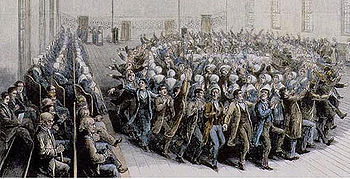Shaker (religion)
The Shakers ( English for "shakers") are a Christian free church in the USA that emerged from Quakerism . Its actual name is United Society of Believers in Christ's Second Appearing . The members refer to themselves simply as "the Believers". The name "Shaker" is derived from the ritual shaking dance, which they consider to be a form of worshiping God, and is a contraction of Shaking Quakers .
Origin and teaching
The religious community was founded in the 18th century by Ann Lee , who was born in 1736 as the daughter of a blacksmith in Manchester and worked there as a weaver in a factory . In 1774 she emigrated to the American state of New York with a small group of her followers. After a few years they founded the first community in Niskayuna in Albany County (Watervliet).
The Shaker religious community is characterized by a high work ethic and an almost monastic , celibate community life . The Shaker communities were most widespread around the middle of the 19th century with around 20 settlements and 6,000 members. Around 1920 there were still twelve communities; now only two members.
With the shakers, men and women share the management functions equally as so-called elders (elders and eldresses). The theological guidelines of the Shaker reflect philosophical currents from the Age of Enlightenment . Jesus of Nazareth is also not considered to be the Son of God, but only became one through the divine voice at his baptism. The designation Christ is a later theological interpretation of his work. The expectation of the second coming of Christ is understood spiritually; it takes place inside people. Ann Lee could also be considered a "returning Christ" without any claim to identity with Jesus Christ being made.
The shake dance as a form of prayer gave contemporaries such as Charles Dickens and Herman Melville an opportunity to mock the strange-looking community. But the Shakers represented much more than just a dancing commune. They also expressed their faith in adherence to Calvinist economic principles: “ Hands to work and Hearts to God ” (German: “The hands at work, the hearts with God”).
For the Shaker, virtues such as hard work , creativity and the pursuit of the highest quality craftsmanship are basic requirements for a godly, joyful life. The work they see as worship plays a central role in Shaker life. Therefore, the Shaker communities in the east of the USA were among the wealthiest and most economically successful in the country in the mid-19th century, and this also resulted in an above-average education among their members. The functional, unadorned architectural style of the Shaker houses is still exemplary today when it comes to architectural solutions for room design and indirect interior lighting using borrowed light . Shakers do not reject technical progress , rather numerous inventions such as the power harrow , an early washing machine , the clothespin and the circular saw resulted from their ventures . The Shakers of the 19th and early 20th centuries traded on the stock exchange, were considered accomplished financial service providers and were on the advisory boards of six US presidents, including those of Abraham Lincoln and Theodore Roosevelt .
Shakers do not live together as families, but celibate for the sake of the kingdom of heaven and without private property. However, men and women lived under one roof. Children who were accepted into the community were offered to join or leave the community after they turned 21. The same applied to foundlings, who were often entrusted to shaker communities.
New members came into the community through incoming adults and orphans. With the spread of state orphan welfare, the communities lost a large part of their potential offspring. At the beginning of 2017 there were still two active members; they live in Sabbathday Lake Shaker Village in the US state of Maine . Church services and spiritual retreats take place there regularly.
Shaker communities
| founding | closure | local community | US state | Illustration |
|---|---|---|---|---|
| 1787 | 1947 | New Lebanon | new York |
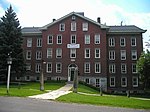
|
| 1787 | 1938 | Watervliet ( Colonie ) | new York |

|
| 1790 | 1960 | Hancock | Massachusetts |

|
| 1790 | 1917 | Enfield | Connecticut | |
| 1791 | 1919 | Harvard | Massachusetts |

|
| 1792 | (?) | Tyringham | Massachusetts | |
| 1792 | 1992 | Canterbury | New Hampshire |
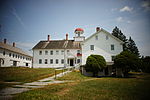
|
| 1793 | 1931 | Alfred | Maine |

|
| 1793 | 1918 | Enfield | New Hampshire |
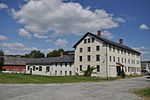
|
| 1793 | 1908 | Shirley | Massachusetts |
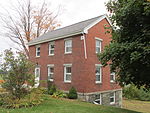
|
| 1794 | til today | Sabbathday Lake | Maine |

|
| 1804 | (?) | Gorham | Maine | |
| 1805 | 1910 | Union Village | Ohio | |
| 1806 | 1910 | Watervliet ( Kettering ) | Ohio | |
| 1806 | 1910 | Pleasant Hill | Kentucky |

|
| 1807 | 1922 | South Union | Kentucky |

|
| 1810 | (?) | West Union ( Busseron Township ) | Indiana | |
| 1817 | (?) | Savoy | Massachusetts | |
| 1822 | 1889 | North Union | Ohio |

|
| 1824 | (?) | Whitewater | Ohio |

|
| 1826 | 1892 | Groveland | new York |

|
Shaker furniture
Today the Shaker furniture and architecture of the Shaker are better known than the religious community itself. The Shaker furniture style is now classified as an independent and influential contribution to art history. Shaker furniture was already widespread throughout the USA in the 19th century and was also presented at world exhibitions. Its formal rigor, the renunciation of ornamentation and the orientation towards usefulness show parallels to the English arts and crafts movement and also influenced modern architecture and design at the beginning of the 20th century. The shakers are also known for the production of oval chip boxes , so-called “shaker boxes”.
literature
- Charles Sealsfield : The Schäkers in North America . In: Das Ausland, 1828, No. 7, pp. 25–26 (available online at Wikisource )
- Karl Mang, Wend Fischer, Werner Bodenheimer (translator): The Shaker. The life and production of a commune in the pioneering days of America . Exhibition New Collection , Munich 1974 (without ISBN)
- June Sprigg, David Larkin, Michael Freeman (Photographer): Shaker. Art, craft, everyday life. Translated from Betha Sauter. Maier, Ravensburg 1991 ISBN 978-3-473-48364-8
- Michael Horsham, Henrietta Wilkinson: The art of the Shaker (translator Inge Kahlix), Könemann, Cologne 1996 ISBN 3-89508-190-6 . Original: The art of the Shakers
- Kerry Pierce: Shaker Furniture. History and Crafts in Pleasant Hill. German by Waltraud Kuhlmann, HolzWerken im Vincentz Network, Hanover 2008, ISBN 978-3-86630-929-6
- Tanja Kasischke: Where there is no government, there is no god: civil religion in the antebellum America using the example of the Shaker community . Verlag Peter Lang GmbH, International Science Publishing House; Edition: 1st edition (June 12, 2008), ISBN 978-3-631-58181-0
Web links
- "200 Years of Shaker in the United States" is a radio report in the online archive of the Austrian Media Library
References
- ↑ Mary Stagaman: Simple Gifts. In: Cincinnati Magazine. September 2003, p. 31.
- ^ Henry Plummer: The Silent Eloquence of Shaker Architecture. Indiana University Press, Bloomington 2009, ISBN 978 0253353627 .
- ↑ Richard Gonzales, One Of The Last Shakers Dies , NPR , Jan. 3, 2017; and: The Sabbathday Lake Shakers (maineshakers.com): Sister Frances Carr . Both web links accessed February 4, 2017.
- ^ Sabbathday Lake Shaker Village: News ; Retrieved February 4, 2017.
